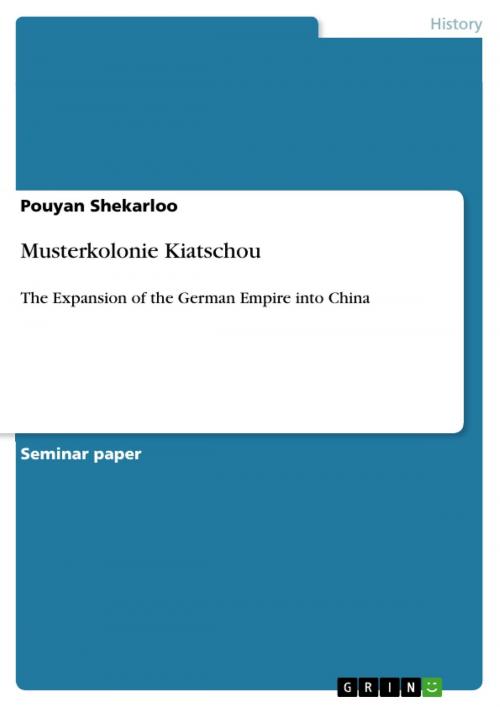| Author: | Pouyan Shekarloo | ISBN: | 9783640777334 |
| Publisher: | GRIN Publishing | Publication: | December 14, 2010 |
| Imprint: | GRIN Publishing | Language: | English |
| Author: | Pouyan Shekarloo |
| ISBN: | 9783640777334 |
| Publisher: | GRIN Publishing |
| Publication: | December 14, 2010 |
| Imprint: | GRIN Publishing |
| Language: | English |
Seminar paper from the year 2010 in the subject History Europe - Germany - 1848, Empire, Imperialism, grade: 1-, The American Central University (Department of History), course: Empire in Comparative History, language: English, abstract: On November 14, 1897, German marines seized the bay of Kiautshou, a small territory on the North-Eastern province of China, Shandong. It was a sudden coup, conducted without any prior negotiations or warnings by the German side; however, in the same way it was knocked off and taken away by Japanese troops in 1914. During the seventeen years of German occupation, the German colonial administration under the guidance of the German Imperial Naval Office (Reichsmarineamt), spent huge sums of money and committed great personal efforts to transformed Kiautshou from a rural and underdeveloped area into a modern and prosperous German Model Colony (Musterkolonie). Kiautshou was not thought of to be a settler's colony but instead it was to become a naval base for Imperial Germany and an economic center for German industry and trade in East Asia. One of the main characteristics of Kiautshou was the idea of a model colony as a mean of representation and propaganda for Germany at home and abroad. The creation of a model colony was intended to demonstrate a specific German colonialism, where careful planning, professional execution, and public supervision were an example for a modern and enlightened imperial policy in contrast to the private and commercial interest led Anglo-Saxon model of imperialism. Therefore, the most advanced means and technologies of the time were applied to make Kiautshou a showcase to the world ('Schaufenster zur Welt').Schools, hospitals, city planning, railways and mines were established all according to German high standards at home. With time, Qingdao, the actual capital city of Kiautshou, became the 'safest and cleanest city in whole East Asia', with the sixth largest port in China. In this regard Imperial Germany created and implemented a small Germany into China. Alfred von Tirpitz, Secretary of State of the German Imperial Naval Office, was the leading advocate behind the realization of Kiautshou as a model colony. His name stands also for German naval armament (Flottenrüstung) and the beginning of the second phase of German colonial policy in the 1890s. With the backing of the German Kaiser, Wilhelm II, and the accession of Bernhard von Bülow into office, as Secretary of State of Foreign Affairs, and later German Chancellor (Reichskanzler), he was able to create a massive naval force, which was supposed to be the instrument of what was to become German Weltpolitik.
Seminar paper from the year 2010 in the subject History Europe - Germany - 1848, Empire, Imperialism, grade: 1-, The American Central University (Department of History), course: Empire in Comparative History, language: English, abstract: On November 14, 1897, German marines seized the bay of Kiautshou, a small territory on the North-Eastern province of China, Shandong. It was a sudden coup, conducted without any prior negotiations or warnings by the German side; however, in the same way it was knocked off and taken away by Japanese troops in 1914. During the seventeen years of German occupation, the German colonial administration under the guidance of the German Imperial Naval Office (Reichsmarineamt), spent huge sums of money and committed great personal efforts to transformed Kiautshou from a rural and underdeveloped area into a modern and prosperous German Model Colony (Musterkolonie). Kiautshou was not thought of to be a settler's colony but instead it was to become a naval base for Imperial Germany and an economic center for German industry and trade in East Asia. One of the main characteristics of Kiautshou was the idea of a model colony as a mean of representation and propaganda for Germany at home and abroad. The creation of a model colony was intended to demonstrate a specific German colonialism, where careful planning, professional execution, and public supervision were an example for a modern and enlightened imperial policy in contrast to the private and commercial interest led Anglo-Saxon model of imperialism. Therefore, the most advanced means and technologies of the time were applied to make Kiautshou a showcase to the world ('Schaufenster zur Welt').Schools, hospitals, city planning, railways and mines were established all according to German high standards at home. With time, Qingdao, the actual capital city of Kiautshou, became the 'safest and cleanest city in whole East Asia', with the sixth largest port in China. In this regard Imperial Germany created and implemented a small Germany into China. Alfred von Tirpitz, Secretary of State of the German Imperial Naval Office, was the leading advocate behind the realization of Kiautshou as a model colony. His name stands also for German naval armament (Flottenrüstung) and the beginning of the second phase of German colonial policy in the 1890s. With the backing of the German Kaiser, Wilhelm II, and the accession of Bernhard von Bülow into office, as Secretary of State of Foreign Affairs, and later German Chancellor (Reichskanzler), he was able to create a massive naval force, which was supposed to be the instrument of what was to become German Weltpolitik.















